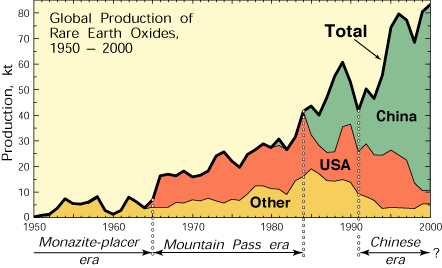Part 4 of the Critical Minerals series

Source: US Geological Survey, public domain.
The purpose of this series is to dig into a few of the minerals labeled critical and explore their properties, uses, and the dangers they present, and to present some alternatives which mining and energy industries don’t tell us about.
When people speak of rare earth elements (REEs) in relation to green energy, they are usually referring to four elements–neodymium, praseodymium, dysprosium and terbium–used to make permanent magnets, which are essential parts of wind turbine generators and EV traction motors. REEs also have significant military uses in items like cruise missiles and so-called “smart” bombs.
REEs are not actually rare, but their ores require much processing, and they typically do not occur in concentrations.
Despite their abundance, it appears the world supply is insufficient for a clean energy transition. A recent report from the European Commission’s Joint Research Center asserts that the IPCC’s 1.5 degree goals cannot be achieved using only rare earth elements:
“[T]he projected supply is not sufficient to meet the anticipated increase in demand. To complete the green transition and achieve our climate ambitions, it is paramount that material usage in existing applications is improved and that alternative technologies are developed that do not rely on rare earth elements. “
The great majority of rare earth mining and processing occurs in China. REEs are thus classified as critical because the US and Europe do not have easy domestic access to them. Recall the “rare earth crisis” of the early 2010s which was primarily a US-China trade issue, ginned up by the US military.
Out of this crisis came legislation to relax taxes, permits, and monopoly laws to allow for the reopening of the Mountain Pass Mine in California. This mine now claims to produce almost 16% of the world’s REEs. Mountain Pass’s history includes over 60 toxic spills, many unreported, nearly all radioactive; a toxic spill led to its closure in 2002. Its reopening involved several corporate reorganizations and a bankruptcy proceeding. Mountain Pass now claims to have “state-of-the-art environmental systems.” It is difficult to test this claim, but we note that all REE ores contain thorium and uranium.
It is even more difficult to assess the environmental effects of REE mines and processing facilities in China. There is evidence that China has a number of unofficial, unregulated sites, which raise labor, human rights, and environmental concerns.
The full Critical Minerals series can be found at the links below: